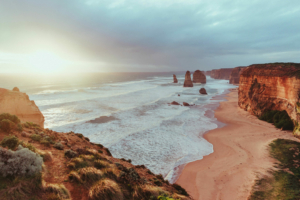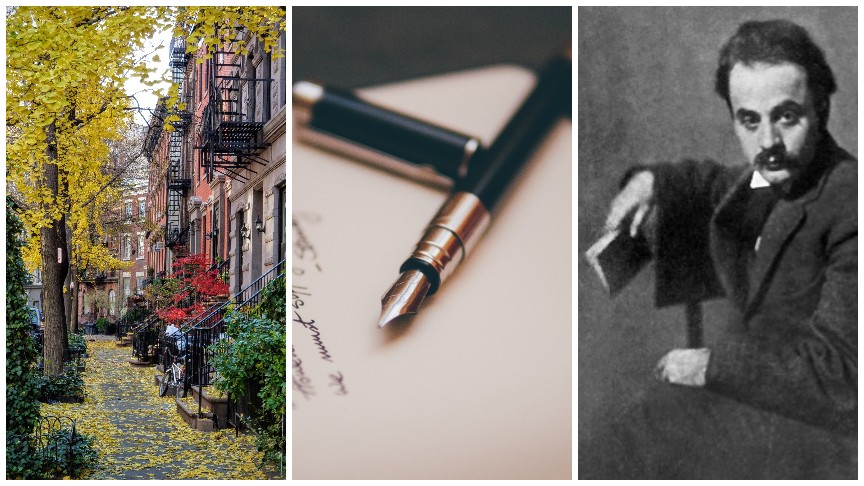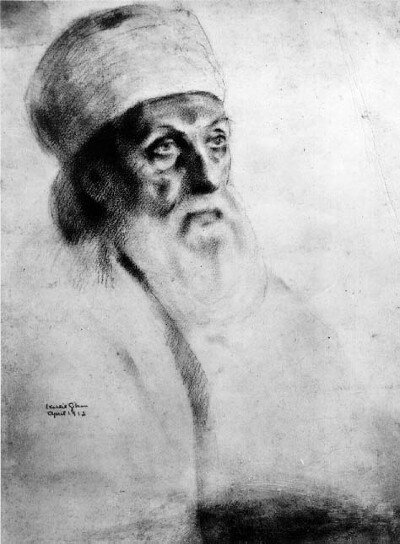Highlighting Australia
- As a proudly Australian initiative, we’re excited to showcase a collection of Australian stories, music, tributes and more.

Join activities, celebrations, study groups, spiritual empowerment and education programs for young people, and more.
Baha’i beliefs address essential spiritual themes for humanity’s collective and individual advancement. Learn more about these and more.


Greenwich Village has historically been an attractive place for writers, scientists, artists and politicians, including during the time of Abdu’l-Baha’s visit to New York City in 1912, when He spoke in churches, temples, universities and at a peace conference. This article is an attempt to shine light on this neighborhood blessed by the footsteps of the Master, and to focus particularly on the relationships between Abdu’l-Baha and two artists living there, Juliet Thompson and Khalil Gibran.
When Juliet Thompson, one of the Disciples of Abdu’l-Baha, moved to New York City, she made her home in Greenwich Village, on W. 10th St. near Fifth Avenue. This neighborhood was a haven for artists and writers, and she fit right in. Washington Square Park, a few blocks south, was the heart of the village and reflected the changing nature of the area. On the north side of the park were the large homes of wealthy business families. These were shuttered during the summer as the families left for their country homes. When they returned and the social season began, one would see well-dressed, affluent New Yorkers stepping out of the doors of expensive automobiles opened by men dressed in livery and then onto red velvet carpets protected by canvas canopies raised overhead.
Artists and writers lived in the dilapidated buildings, cottages and frame houses south of the square. This area was home to the pamphleteer Thomas Paine, and writers Edgar Allan Poe, Mark Twain, Robert Louis Stevenson, Emma Lazarus, Khalil Gibran and O. Henry, among many others. The cheap rent, bustling atmosphere of small restaurants, shops and tiny obscure theaters were attractions for artist and writers.
This was an age when more people were searching outside of mainstream churches for alternatives or broader belief systems. Among these alternatives were spiritualism, the belief that God is transcendent and cannot be described in anthropomorphic terms and that spirits can contact us from the next world, theosophical societies, which taught that God was everywhere, that human nature was ultimately Divine and that sickness could be healed through “right thinking”, and Hinduism and Buddhism which were only taught or understood in fragments.
These movements tended to have a more universal view of God and salvation than traditional churches, and people were more willing to discard or go beyond long accepted church doctrines. Many of these seekers continued to be Christian in terms of its social and spiritual teachings and some involvement in a church.
For some, the Baha’i Faith appeared to be one of these “alternatives”, with a charismatic rather than formal community structure, and, as far as people knew, with general spiritual teachings such as the unity of the human race and the promotion of world peace which echoed what many people regarded as the needs of the day and which did not challenge their already held opinions on other subjects. In this sense, the pre-World War I spirit of the age reflected some aspects of Baha’u’llah’s Teachings.
Greenwich Village was also home to Mrs. Roosevelt and to the Russian revolutionary leader Leon Trotsky and other free thinkers who had political leanings, most notably, anarchists, who saw governments as oppressive and emphasized personal freedom, and communists, who believed in a classless egalitarian society where government controlled the means of production to ensure social and economic equality. These kinds of political views had grown in response to the terrible conditions of workers in industrialized societies. There were also many trade unionists who advocated for workers’ rights. In His talks in the United States, Abdu’l-Baha would bring a broader spiritual perspective to each of these issues by explaining the need for a Divine Educator, the nature of true spirituality, the necessity of both social justice and social order, and the meaning of true equality, among others.
Juliet Thompson chose to live in this powerful mix of new ideas and changing cultures when she moved to W. 10th St. Her residence would also be home to other artists and writers during her many years there. The residents of the house often shared their work with each other. Salons sponsored by a patron where artists, writers and thinkers could gather to discuss current topics of interest in art, spirituality and politics took place regularly in this part of the city. Juliet was a painter and a writer and had profound spiritual sensibilities. While she did attend the Church of the Ascension off and on, she trusted her personal experience when it came to matters of faith which helped her to respond to the Baha’i message.
Among Juliet’s closest friends was a well-known writer and artist and a fellow seeker: Khalil Gibran. Gibran lived across the street from Juliet in 51 W. 10th St. He had been born in northern Lebanon, then a part of the Ottoman Turkish Empire. His mother’s family included a bishop in the Syrian Church. Too poor to go to school, he was educated in the Scriptures by local priests. As a young person, Gibran dreamed of creating unity and understanding between the two great faiths which dominated his homeland, Islam and Christianity, and which had been in violent conflict a few years before his birth. His mother left Lebanon for the United States after his father was imprisoned for embezzlement. To develop his obvious artistic talents in drawing and painting, he studied in Beirut, Boston and Paris, under Auguste Rodin. Throughout his life he maintained an intense feeling for the figure of Jesus Christ whom he re-imagined in his writing in different ways than that of traditional churches. Like many people of this time, Gibran’s spiritual beliefs tended towards the theosophical, and he wasn’t sure if a Divine Manifestation was necessary and that, instead, individuals could perfect themselves and come into contact with God. Juliet visited his studio and praised his work as did Marjorie Morten, a patron of the arts, who was also a Baha’i. Gibran became such close friends with Juliet that he often let her read his drafts. Juliet introduced the Baha’i Faith to Gibran by giving him Baha’u’llah’s Hidden Words in Arabic. Profoundly moved, he described them as “stupendous literature”. Gibran also met Abdu’l-Baha through Juliet.

The Master’s powerful spiritual presence greatly influenced his work, especially his 1928 book, Jesus Son of Man. Gibran’s The Prophet, written a few years earlier, would go on to influence generations of people who hungered for spiritual inspiration. Gibran spent the winter of 1912 as a recluse; he was so absorbed in his work that he would hardly eat, instead drinking strong Turkish coffee and smoking. But as spring of 1912 arrived, he began to rejoin the social world. He came to adore Abdu’l-Baha. In explaining why Abdu’l-Baha was such an inspiration for his book on Jesus, he said, “For the first time I saw form noble enough to be a receptacle for the Holy Spirit.” Very early on the morning of April 19th, Abdu’l-Baha sat for a portrait painted by Gibran. They had met three times previously about the portrait; Gibran had also acted on those occasions as an interpreter. The night before he hadn’t been able to sleep. After an hour of painting, the twenty-five onlookers in the room began exclaiming that he had captured the soul of the Master in his portrait. Abdu’l-Baha said to him in Arabic: “Those who work with the Spirit work well. You have the power of Allah in you, and, quoting Mohammed, said: ‘Prophets and poets see with the light of God.’” Gibran recorded that in Abdu’l-Baha’s smile, “there was the mystery of Syria and Arabia and Persia.”
Sources:
Thompson, Juliet. The Diary of Juliet Thompson.
Ahdieh, Hussein. Abdu’l-Baha in New York.
Mahmud-i-Zarqani. Madmud’s Diary.
"*" indicates required fields

We recognise their continuing connection to land, waters and community. We pay our respects to Aboriginal and Torres Strait Islander people and their cultures; and to elders both past and present.
The views expressed in our content reflect individual perspectives and do not represent authoritative views of the Baha’i Faith.

Visit the site of the
Australian Baha’i Community
and the Baha’i Faith Worldwide
Notifications
What an excellent article! Thank you Dr
Ahdieh.
Michael V Day (August 8, 2021 at 12:52 AM)
Thank you Mr.Day!
I appreciate your kind words!
Warmly,
Hussein
Hussein Ahdieh (August 8, 2021 at 5:48 PM)
I enjoyed reading this article.
Hooshang Sadeghi-Afshar (August 8, 2021 at 12:04 AM)
Thank you for reading it dear Houshang!
Feel free to share it,
Warmly,
Hussein
Hussein Ahdieh (August 8, 2021 at 3:54 PM)
Thank you Dr. Ahdieh! I have always been an avid reader of Gibran’s work and found the connection with the Baha’is and Abdul-Baha truly fascinating. Thank you for painting a picture of the climate and environs of Greenwich Village during that time.
Pharan Akhtarkhavari (August 8, 2021 at 7:06 AM)
You will enjoy Juliet Thomson diary, if you haven’t read it.
Thank you for your comment!
Warmly,
Hussein
Hussein Ahdieh (August 8, 2021 at 7:36 PM)
Dear Mr Ahdieh, is there any praise, poem or appreciation of Khalil Gibran for Abdu’l-Baha?
Thanks
Shahrokh
Shahrokh makhanian (October 10, 2021 at 5:41 PM)
Unfortunately I am not aware of any!
Hussein Ahdieh (November 11, 2021 at 5:14 PM)